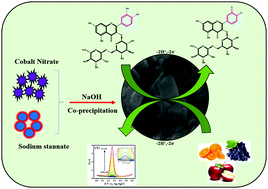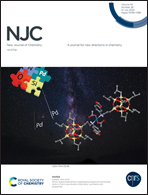Simple synthesis of CoSn(OH)6 nanocubes for the rapid electrochemical determination of rutin in the presence of quercetin and acetaminophen
Abstract
This work focuses on the synthesis of hydroxide perovskite-based CoSn(OH)6 nanocubes (CSO NCs) by a simple co-precipitation method towards the rapid detection of rutin. The as-prepared CSO NCs were confirmed and characterized by instrumental techniques such as Fourier transform infrared spectroscopy (FT-IR), X-ray diffraction spectroscopy (XRD), and field emission scanning electron microscopy (FE-SEM). Examination of the electrochemical properties including different pH levels, effect of loading, scan rate, interference, and stability of the rutin on the CSO NCs modified electrode was carried out by cyclic voltammetry (CV) and differential pulse voltammetry (DPV), respectively. Under optimal conditions, the CSO NCs modified electrode exhibits rapid sensing of rutin and delivers an ideal linear range from 0.04 μM to 15 μM which assists the minimal detection limit (LOD) of 13 nM. The proposed sensor predicts long storage stability, good selectivity, reproducibility and satisfactory recovery in orange, apple and grape juice for the determination of rutin. Therefore, the present work provides a new way to extend analytical applications in the electrochemical sensor field.



 Please wait while we load your content...
Please wait while we load your content...